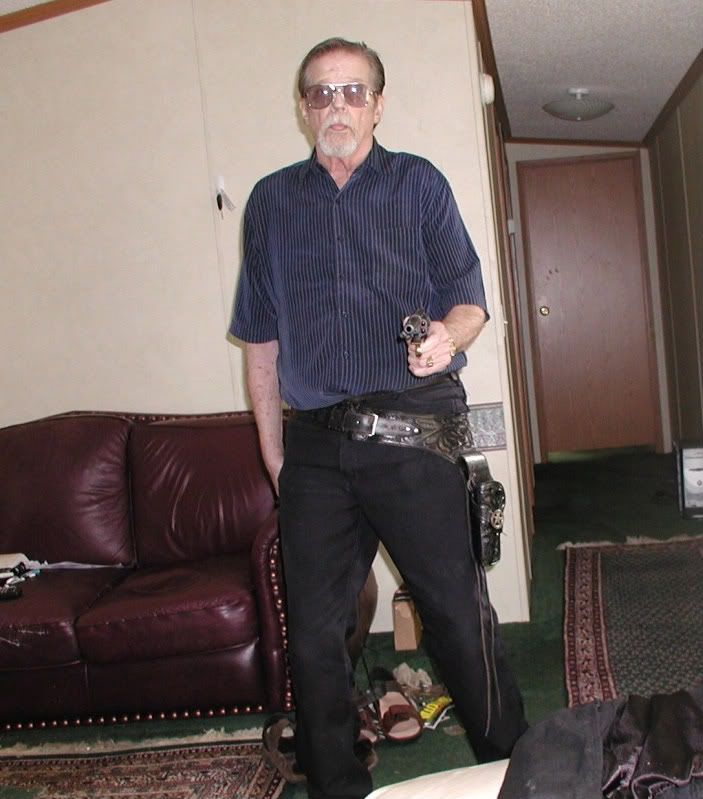LouisianaMan
New member
Applegate
Yes, Applegate advocated bringing it up to eye level and shooting when the gun "covered the target." As a matter of fact, F&S did too, except at very close ranges. Their proposed "recruit training" started with raising the pistol to eye level, and shooting the moment it covered the target. The recruit was supposed to concentrate on the middle of a human figure centered on an 8' x 8' target.
A weakness in my first foray into point shooting is that I looked at the box, rather than concentrating on the center of the box. . .the larger "target" probably let me shoot faster, at the cost of some precision. FWIW, F&S asserted that 50% hits was OK, as "experience had proved that to be adequate to the purpose in view." (I love the old-fashioned British lingo!)
Without double-checking the book, F&S basically advocated:
* 1/4 hip (heel of firing hand snug against your ribs) at grappling distance, i.e. 1 yard.
* 1/2 hip (elbow touching hip, gun on centerline of body) at 2-3 yds.
* 3/4 hip (elbow bent, gun below eye level, gun on centerline of body) at 4-5 yds.
* Eye level, gun on centerline of body, at ranges from about 5-12 yds. I believe they seemed to accept 35 ft. as the approx. outer limit of effectiveness; Applegate, I think, stated about 50 ft. as max.
Yes, thanks for the reminder on the title of Applegate's book, Kill or Be Killed. I also bought a DVD of the WWII training film he helped put together on combat pistol shooting. It's about 15-18 mins. long, and shows his basic "pump handle" technique as demonstrated by some soldiers using M1911A1's with tracer ammo vs. silhouette targets. His approach basically simplified F&S to a single stance, i.e. raising gun to eye level, rather than the several F&S variations mentioned above. Good, simple, easy, fast. I do, however, want to see if the F&S techniques let me shoot faster and better at extremely close ranges, to lessen the chance of having my raised pistol snatched.
Also, as nNobby 45 points out, SD/HD shooting for a civilian is highly likely to occur in low light; that's another point emphasized by F&S + Applegate. And I also agree with his hope that this isn't becoming a "my approach is better than yours" thread. I'm simply tossing out there what I recently learned (1930's techniques!! and my results so far, plus summarizing the proponents' reasons for their techniques. My opinion is strictly "to each his own." But with my weakening eyes and recently-developed hand tremor, as well as the low light condition of my house at night, I really appreciate these new-to-me techniques that don't emphasize good vision, steady hands, and visible sights.
and my results so far, plus summarizing the proponents' reasons for their techniques. My opinion is strictly "to each his own." But with my weakening eyes and recently-developed hand tremor, as well as the low light condition of my house at night, I really appreciate these new-to-me techniques that don't emphasize good vision, steady hands, and visible sights. 
Yes, Applegate advocated bringing it up to eye level and shooting when the gun "covered the target." As a matter of fact, F&S did too, except at very close ranges. Their proposed "recruit training" started with raising the pistol to eye level, and shooting the moment it covered the target. The recruit was supposed to concentrate on the middle of a human figure centered on an 8' x 8' target.
A weakness in my first foray into point shooting is that I looked at the box, rather than concentrating on the center of the box. . .the larger "target" probably let me shoot faster, at the cost of some precision. FWIW, F&S asserted that 50% hits was OK, as "experience had proved that to be adequate to the purpose in view." (I love the old-fashioned British lingo!)
Without double-checking the book, F&S basically advocated:
* 1/4 hip (heel of firing hand snug against your ribs) at grappling distance, i.e. 1 yard.
* 1/2 hip (elbow touching hip, gun on centerline of body) at 2-3 yds.
* 3/4 hip (elbow bent, gun below eye level, gun on centerline of body) at 4-5 yds.
* Eye level, gun on centerline of body, at ranges from about 5-12 yds. I believe they seemed to accept 35 ft. as the approx. outer limit of effectiveness; Applegate, I think, stated about 50 ft. as max.
Yes, thanks for the reminder on the title of Applegate's book, Kill or Be Killed. I also bought a DVD of the WWII training film he helped put together on combat pistol shooting. It's about 15-18 mins. long, and shows his basic "pump handle" technique as demonstrated by some soldiers using M1911A1's with tracer ammo vs. silhouette targets. His approach basically simplified F&S to a single stance, i.e. raising gun to eye level, rather than the several F&S variations mentioned above. Good, simple, easy, fast. I do, however, want to see if the F&S techniques let me shoot faster and better at extremely close ranges, to lessen the chance of having my raised pistol snatched.
Also, as nNobby 45 points out, SD/HD shooting for a civilian is highly likely to occur in low light; that's another point emphasized by F&S + Applegate. And I also agree with his hope that this isn't becoming a "my approach is better than yours" thread. I'm simply tossing out there what I recently learned (1930's techniques!!


